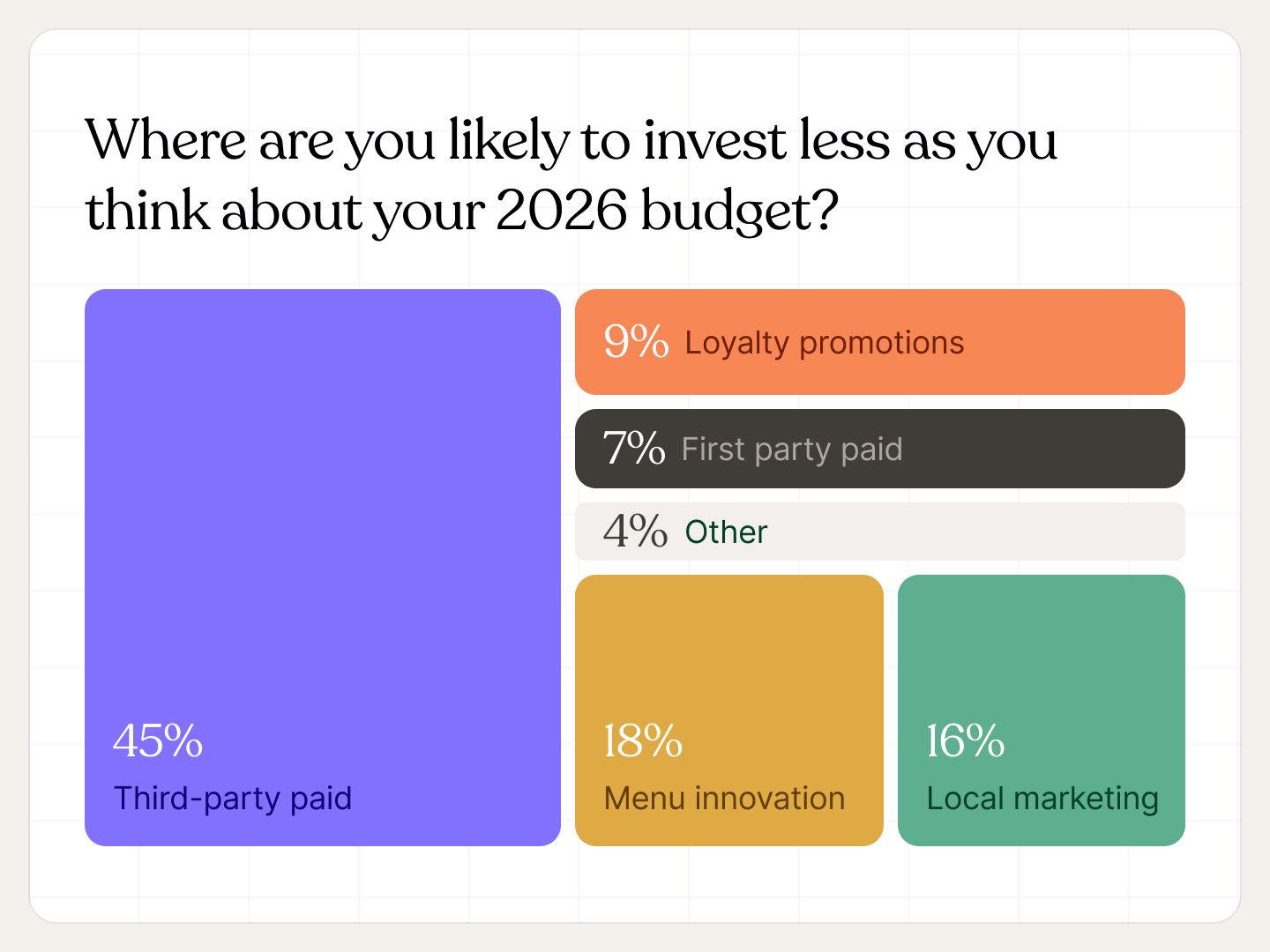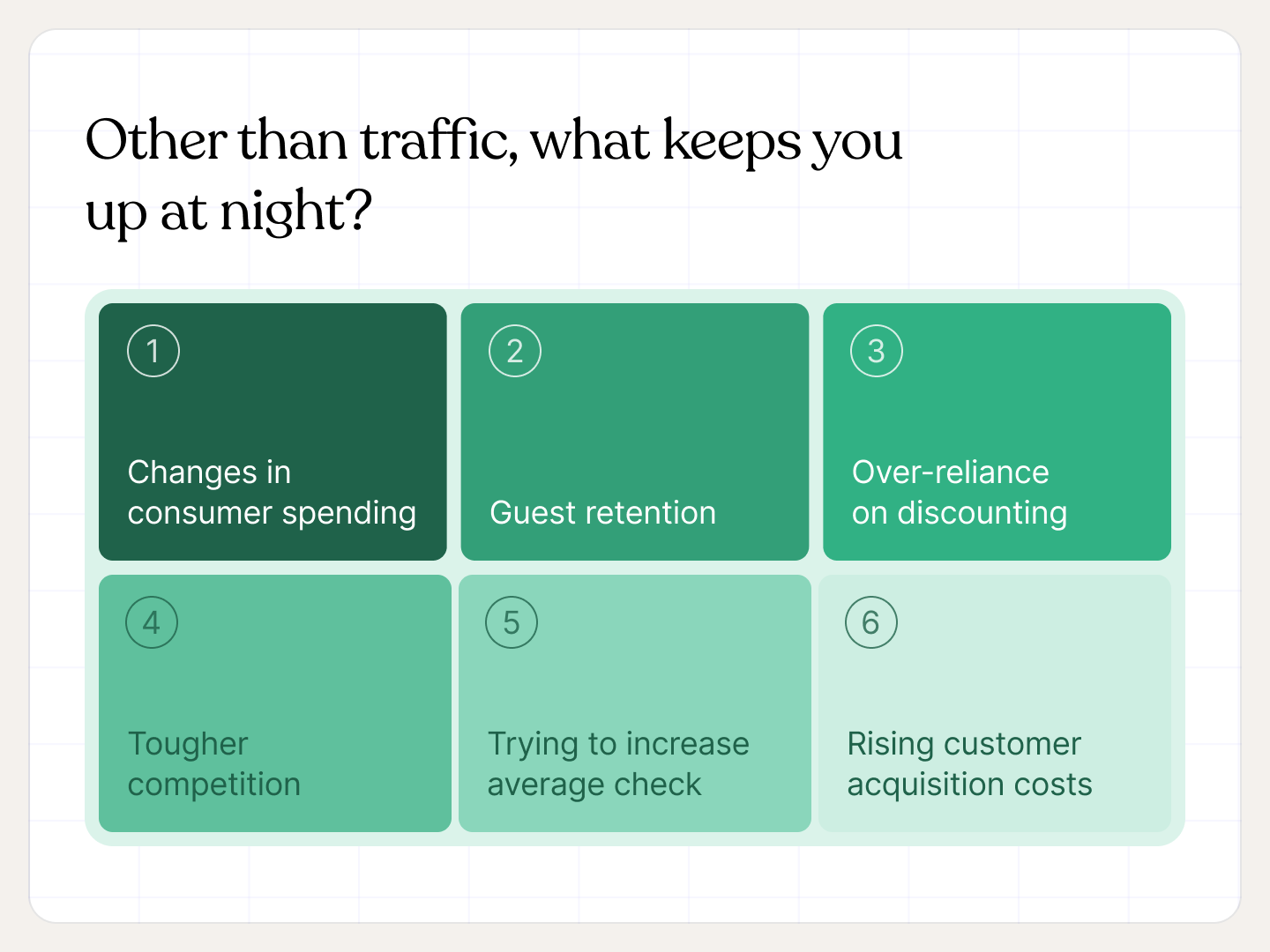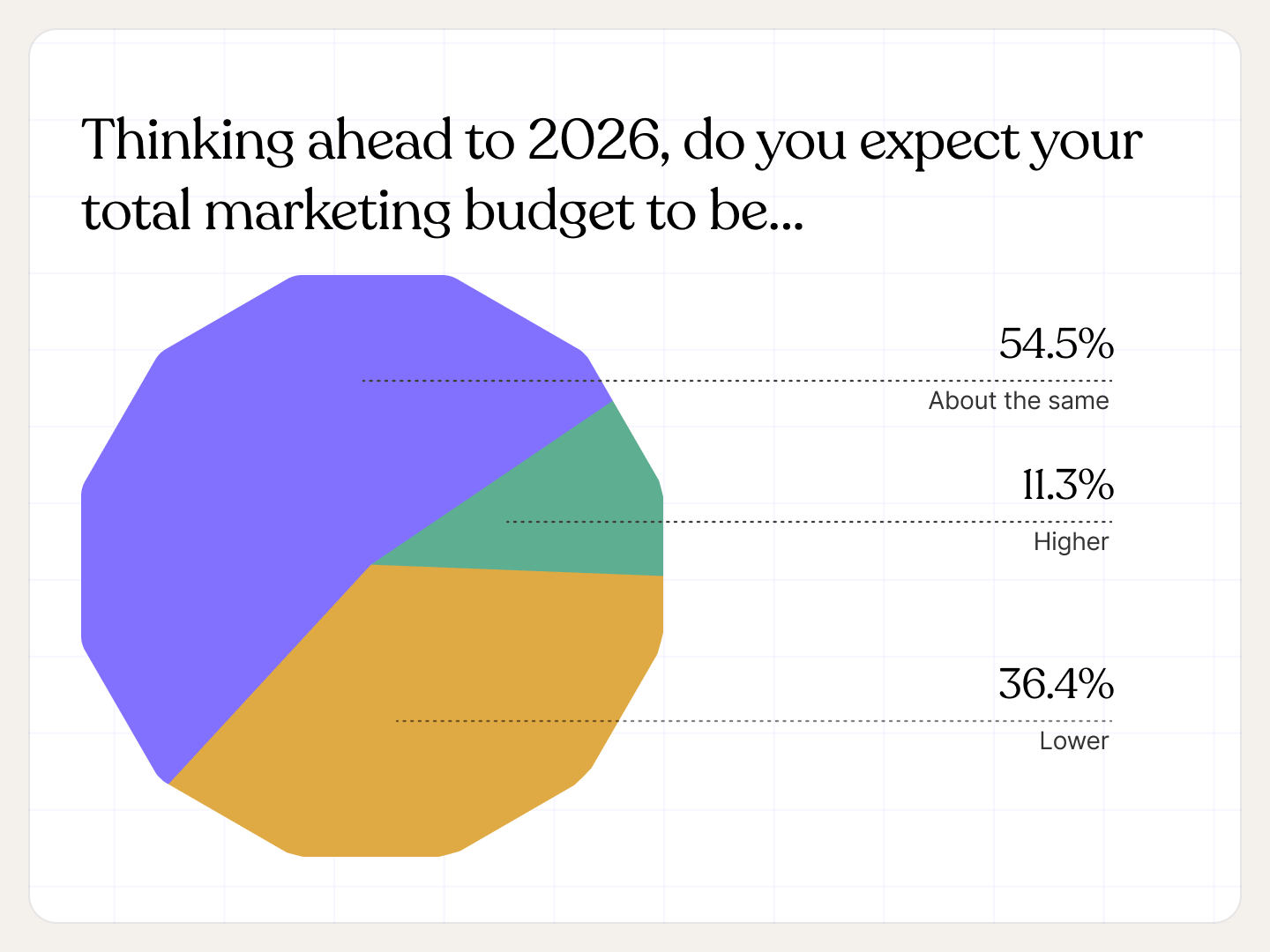
In a tough consumer environment, brands are pulling every possible lever to grow traffic: promos, discounts, combos, LTOs, paid ads. With industry sales for top chains expected to grow at the slowest rate in the past decade (not including 2020), CMOs are pulling out all the stops.
But what’s actually driving traffic? What tactics are showing the highest ROI? And what’s getting scaled - or cut - in 2026?
In Bikky’s inaugural CMO survey, we asked nearly 50 multi-unit restaurant marketing leaders for their thoughts.
In a nutshell: budgets are flat, and the mix is changing. First-party digital now leads traffic growth, and third-party ad spend is (to our surprise) the #1 area marketers plan to cut in 2026. At the same time, loyalty promotions both fuel growth and stoke anxiety about discount dependence.
Here are our biggest takeaways:
Since the pandemic, third-party marketplaces have been the clearest growth lever for restaurants. They’ve poured billions into aggregating supply and demand and optimizing the digital dining journey end-to-end. Despite ongoing debate over commissions, many large brands still see incremental customer acquisition from these channels. In its most recent earnings release, Domino’s said its new DoorDash partnership was ~50% incremental and noted its 2024 Uber Eats partnership was even higher at ~66%.
Ads Became the Margin Engine
Given the tough economics of delivery, marketplaces doubled down on advertising in recent years. These are pure-margin products delivered at near-zero marginal cost with tight attribution, often adding an effective 10-15% commission per order upon conversion. That incentive shows up in the field: customers tell us marketplaces are offering meaningful marketplace concessions if brands ensure franchisees run at least one promo or sponsored listing every day of the year. And it’s working - DoorDash’s ad business has reached a roughly $1B run rate, despite launching only in 2021.
The Channel Is Normalizing
Given the growth, competitive, and inflation challenges over the past couple of years, brands have taken the bait. Understandably so - commission relief is a meaningful win for franchisees and store-level P&Ls.
But our survey data suggests a shift. Third-party ranked second for fastest growth so far this year (27%), behind first-party ordering at 31%. Looking ahead, third-party ads also received the most votes for where marketers will invest less in 2025 (45%) - more than double the next option (menu innovation). And while third-party ads still rank third for highest ROI in 2025, as Protein Bar & Kitchen COO Jared Cohen noted, the relentless push for promotions may have saturated what was once a reliable, fast-growing source of traffic.

When traffic slips, promotions are the quickest lever most brands pull. You can show immediate value to your guests if you just lower the effective price they pay.
It’s no surprise then that 50% of marketers in our survey said this was their primary value strategy in 2025. Our data backs up this sentiment; looking across the brands we work with at Bikky, the average discount rate increased from 7.8% in 2024 to 9.0% in 2025.
But there’s clear tension with this tactic. While promos ranked as the highest ROI activity this year, it only secured 25% of votes. On the other hand, 30% of respondents flagged that over-reliance on discounting as their top concern with their value strategy.
In short, the relationship with loyalty promotions is complicated. Marketers are leaning into them more, but there’s debate on the ROI. There’s also the worry about relying too much on them - and risk going down the slippery slope towards becoming a “discount brand.” And yet, at the same time, only four respondents plan to actually invest less in promotions in 2026.


The lack of pullback is probably the most important data point here - the flip side of offering more promotions is that there is a tight correlation with first-party / loyalty order growth. More than half of our respondents ranked the channel as one of the two fastest growing channels in 2025.
The combination of these data points - combined with lighter third party ad investment - suggests that building the first party funnel will be a clear priority in 2026. With 70%+ of transactions in the restaurant industry still happening offline, brands are eager to growth their own first-party databases. The challenge will be threading the needle - running more effective, data-driven offers, rather than blanket promos that risk sliding into over-discounting.
MOOYAH is one of the clearest examples of how a brand can balance an aggressive loyalty acquisition strategy with disciplined discounting. They’ve tested and validated a rich sign up offer that gives a guest a free burger before their first loyalty visit, while still maintaining a net discount rate below 5%. While the perception might be that this offer attracts too many deal-seekers, they were able to validate through Bikky that it acquired more new guests than any other signup offer, while also driving higher than expected repeat order rates.
The shift to look for next year isn’t about paring back the level of discount, but rather moving away from mass, untargeted promotions in favor of precise offers that drive both trial and retention.
Macro / consumer concerns were overwhelmingly the biggest worry on people’s minds, with 66% citing it as the number one factor keeping them up at night.

This sentiment matched what we’ve seen in the most recent earnings season, with previous high flyers like McDonald’s, Chipotle, and CAVA all calling out macro uncertainty as a contributor to softening comps. It’s not clear yet to what extent consumers are trading out, but there’s consensus that it’s harder to both win new guests and maintain frequency from loyal ones.
According to Technomic, menu prices are growing faster than weekly earnings, and >60% of consumers expect prices to go up again over the next six months. Everywhere you look, the data seems to point to softening industry sales and a choppier outlook through the end of the year.
Over 50% of marketers surveyed expect budgets to remain flat in 2026.
So, to recap:
And amidst all that, marketers are being asked to do more with the same amount. Can you “neutral” your way to growth?

Overall, marketers seem to be aligning on the same playbook: if budgets are flat, then dollars will shift from lower-performing / oversaturated channels (third-party marketplaces) to higher ROI initiatives like loyalty promotions and local store marketing (which combined received nearly 50% of votes). So success in 2026 will be defined by those who get more targeted, personal, and local.
We’re starting to see signs of brands successfully using these tactics today, like Bikky partner Mellow Mushroom. To gain greater efficiencies from their promotional spend, the brand is using demographics insights to identify their most price sensitive guests, then tailor offers specifically to them. While still early, they’re already reporting higher conversion rates and ROI on these campaigns. Mellow is also using these insights to understand which locations under-index on transactions from their most loyal - and profitable - guests. They’re now allocating spend to awareness campaigns in these markets to drive transaction growth from guests in their target demographics.
It seems like “flat is the new up” - both when it comes to guest traffic and budgets. CMOs need to be more targeted than ever in deploying marketing dollars.
The survey paints a mixed picture for the year ahead.
While the YTD traffic numbers for respondents vary widely, there’s a shared expectation that the current environment won’t get much more favorable. Budgets are flat, and allocations are shifting to support higher growth, higher margin channels like first party digital / loyalty. At the same time, there is worry that leaning too hard into this channel can lead to an overly promotional competitive environment, the potential consequences of which are brand dilution and a negative traffic spiral.
Looking ahead, there is no easy path to growth. But there are some core themes. When asked what winning CMOs will do in 2026, nearly 40% cited either stronger personalization or better use of data. Several also coupled this “hard” competency with the “soft” requirement of building a brand identity that breaks through the inevitable noise that comes with an ongoing promotional environment.
These tactics are evergreen when it comes to restaurant marketing - staying true to your brand principles, leveraging a deep understanding of your guests, and of course, making sure ops executes well on the guest experience. The brands best positioned for 2026 aren’t those with the biggest budgets or offering the deepest discounts, but those that invest in smarter, data-driven strategies across their marketing, loyalty, and menu efforts.
On a final note, we leave you with the full range of responses of what winning CMOs will do in 2026:
